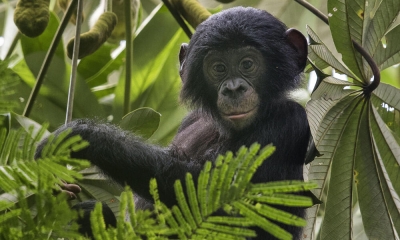
Bonobos and chimpanzees look very similar and both share 98.7% of their DNA with humans—making the two species our closest living relatives. Bonobos are usually a bit smaller, leaner and darker than chimpanzees. Their society is also different—bonobo groups tend to be more peaceful and are led by females. They also maintain relationships and settle conflicts through sex. However, bonobo life isn’t entirely violence free; if two groups of bonobos come together, they may engage in serious fighting.
Wild bonobos can only be found in forests south of the Congo River in the Democratic Republic of Congo (DRC). Sometimes known as the pygmy chimpanzee, bonobos weren’t recognized as a separate species until 1929. As the last great ape to be scientifically described, much remains unknown about the bonobo—including the extent of its geographic range. Efforts to survey the species over the past two decades have been hampered by the remote nature of its habitat, the patchiness of their distribution and years of civil unrest within the DRC.
Civil unrest and increasing poverty in the area around the bonobos’ forests have contributed to bonobo poaching and deforestation. Though the size of the bonobo population is largely unknown, it has likely been declining for the last 30 years. Scientists believe that the decline will continue for the next 45 to 55 years due to the bonobo’s low reproductive rate and growing threats.
Credit : WWF
Picture Credit : Google




